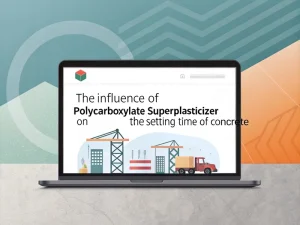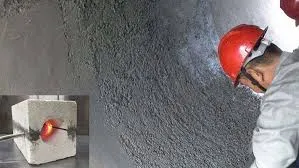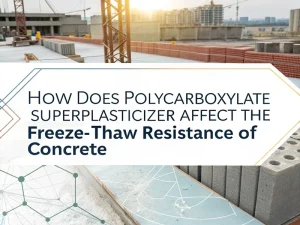
The Influence Of Polycarboxylate Superplasticizer On The Setting Time Of Concrete
Blog The influence of pol
Blog

Refractory concrete refers to a special type of concrete that operates at temperatures ranging from 900 to 1600 degrees Celsius and maintains its physical and mechanical properties, including high refractoriness, thermal stability, a low softening point under load, and minimal shrinkage at high temperatures.
However, the preparation of refractory concrete presents unique challenges: high density and mineral composition (such as alumina, magnesia, and refractory clay) make it naturally viscous, difficult to pour, and highly prone to cracking. The addition of concrete admixtures is crucial for producing top-grade refractory castables that can withstand such harsh environments.
This guide will delve into the unique role of polycarboxylate superplasticizer for refractory concrete, the challenges it faces, and the key technologies for its proper use.
It uses Calcium Aluminate Cement (CAC) as the main adhesive, rather than Portland Cement (OPC) for ordinary concrete. CAC has fast setting, early strength, and excellent high-temperature performance.
It uses high-temperature resistant aggregates such as high alumina alumina, silicon carbide, mullite, corundum, etc., instead of sand and crushed stone.
In refractory concrete, water is not only a necessary medium for achieving hydration reactions and fluidity, but also a huge potential danger. During the first baking and heating process, if residual physical water cannot be discharged smoothly, it will generate huge vapour pressure due to evaporation, leading to structural explosion (Explosive Spalling) and causing catastrophic consequences.
Therefore, one of the core goals of refractory castable technology is to minimise the amount of water added while ensuring construction fluidity, in order to achieve high-density, low porosity, and safe baking performance.
The polycarboxylate superplasticizer used for refractory concrete efficiently disperses aluminate cement and ultrafine powder particles through its unique comb-like molecular structure and steric hindrance effect, thereby bringing four core advantages:
This is the most crucial contribution of PCE. By adding a very small amount of PCE (usually 0.1% to 0.5% of the weight of the cementitious material), the amount of water added to the castable can be reduced by 20% to 40%. This directly brings about:
Lower apparent porosity: With reduced moisture content, fewer pores remain after hardening.
Higher bulk density and strength: The structure is denser, and both the compressive strength at room temperature and the flexural strength at high temperature are significantly improved.
Safer baking process: less internal moisture, greatly reducing the risk of bursting, allowing for faster heating curves, saving energy and time.
PCE can enable castables to achieve excellent flowability and even self-levelling at extremely low water usage. This means:
Complexly shaped furnace linings and prefabricated components can be easily poured without or with minimal vibration.
Obtain a more uniform and defect-free internal structure, eliminating weak points caused by improper vibration.
Developed advanced products such as Low Cement Castable (LCC) and Ultra Low Cement Castable (ULCC).
Shrinkage (dry shrinkage or heat shrinkage) is the main cause of refractory lining failure, and PCE alleviates this problem through a dual mechanism:
Reduce shrinkage: Reducing water consumption directly reduces the volume loss during the curing process. PCE can reduce the shrinkage rate of refractory concrete by 25% -40%, reducing the risk of cracking during the equipment debugging preheating stage (“drying period”).
Optimise hydration reaction: slow down the hydration rate of calcium aluminate cement, making the reaction between water and refractory minerals more uniform, forming a more stable matrix structure and better resisting thermal stress at high temperatures.
Taking steel plants as an example, after using refractory concrete with PCE added to the blast furnace lining, the service life was extended from 12-15 months to 18-24 months, with the core reason being a 50% reduction in the incidence of hot cracking.
Refractory concrete must be tightly bonded to steel or brick substrates to prevent delamination (peeling) caused by gas impact at high temperatures. PCE improves bonding performance through two points:
Dense interface layer: The low porosity matrix adheres more tightly to the substrate, reducing gaps for high-temperature gas infiltration.
Uniform interface distribution: The dispersing effect of PCE enables the refractory particles to be evenly distributed at the substrate concrete interface, forming a stronger mechanical biting force.
Tests have shown that the bond strength between refractory concrete with PCE and steel substrate (ASTM C883 standard) is 40% higher than that of the mixture without PCE, which is crucial for furnace linings that can withstand high-strength thermal shock and gas pressure.
To fully utilise the role of PCE in refractory concrete, the following industry-validated operating standards should be followed:
Not all PCEs are suitable for refractory concrete, and special attention should be paid to “high temperature compatibility” and “mineral compatibility”:
Low VOC, high-temperature stable type: Choose PCE with low volatile organic compound (VOC) content to avoid combustion and pore formation at high temperatures. Priority should be given to selecting models labelled as “fire-resistant” or “high-temperature stable” by suppliers.
Compatible with calcium aluminate cement: Most refractory concretes use calcium aluminate cement (CAC), and PCE that has been tested for compatibility with CAC should be selected (compatibility data sheets can be obtained from suppliers).
Long-term collapse protection type: For large kiln linings and other projects with prolonged pouring times, PCE with a collapse protection time of 60-90 minutes should be selected to ensure stable operation throughout the entire process.
The water-cement ratio of refractory concrete needs to be adjusted according to the application scenario, and the core role of PCE is to ensure fluidity at low water-cement ratios:
High temperature furnace lining: target water cement ratio of 0.30-0.35 (flow demand achieved through PCE);
Prefabricated refractory components: target water cement ratio of 0.35-0.40 (balancing castability and early strength, facilitating demolding).
It is strictly prohibited to add additional water. If the mixture is too dry, the PCE content should be increased within the recommended range of the manufacturer (0.2% – 0.6% of the quality of the cementitious material), instead of adding water, as additional moisture will completely compromise the heat resistance.
The surface characteristics of different refractory aggregates (such as magnesium oxide and silicon carbide) vary greatly, which may affect the PCE effect, and need to be tested in advance:
High alumina aggregate: has good compatibility with most PCEs, but needs to be tested for flowability (aluminium aggregate may adsorb a small amount of PCE, and the dosage needs to be adjusted);
Magnesium oxide aggregate: It is alkaline and may react with some PCE. It is necessary to choose PCE with a neutral pH value (7-8) and verify the dispersion effect through small-scale experiments.
Silicon carbide aggregate: chemically stable, well compatible with PCE, but it is necessary to ensure sufficient dosage of cementitious material to ensure matrix strength.
Refractory concrete has a dense composition and requires precise mixing to ensure even dispersion of PCE.
Mix dry materials first: Add refractory aggregates, cementitious materials, and other additives (such as anti-cracking fibres) to a high shear mixer and stir for 2-3 minutes until uniform.
Add PCE aqueous solution: Dissolve PCE in 70% of the total water volume, then pour it into the dry material and stir for 3-4 minutes.
Add remaining water: Gradually add the remaining 30% water until the target flowability is reached (tested using a jumping table or slump cone).
Attention: Avoid excessive mixing, as it may cause aggregate breakage and reduce heat resistance.
Even fire-resistant concrete mixed with PCE needs to ensure performance through proper curing and preheating:
Maintenance: Cover the concrete with plastic film and keep it moist for 7-14 days (a longer period than for ordinary concrete). Calcium aluminate cement-based refractory concrete requires slow curing to prevent early cracking.
Preheating (drying): Slowly raise the temperature at a rate of 5-10 ℃/hour to 150-200 ℃, and maintain this temperature for 24 hours to gradually remove residual moisture and prevent cracking caused by steam pressure. The low moisture content characteristic of PCE can shorten preheating time and reduce energy consumption.
Refractory concrete requires an admixture that can balance “workability, low porosity, and high temperature stability”, and polycarboxylate superplasticizer (PCE) precisely meets this demand: reducing pores and improving castability through efficient water reduction, reducing cracking risk through controllable hydration, and adapting to extreme environments through high temperature stability characteristics.
By selecting the correct CAC-compatible PCE and following rigorous testing and application procedures, refractory concrete can overcome the performance bottleneck of traditional materials, producing denser, stronger, safer, and longer-lasting refractory products. This provides a solid guarantee for the stable operation of the global high-temperature industry.
Easthony as China polycarboxylate superplasticizer supplier, we prove high quality product, contact with us!

The Influence Of Polycarboxylate Superplasticizer On The Setting Time Of Concrete
Blog The influence of pol

How Does Polycarboxylate Superplasticizer Affect The Freeze-thaw Resistance Of Concrete?
Blog How does polycarboxy